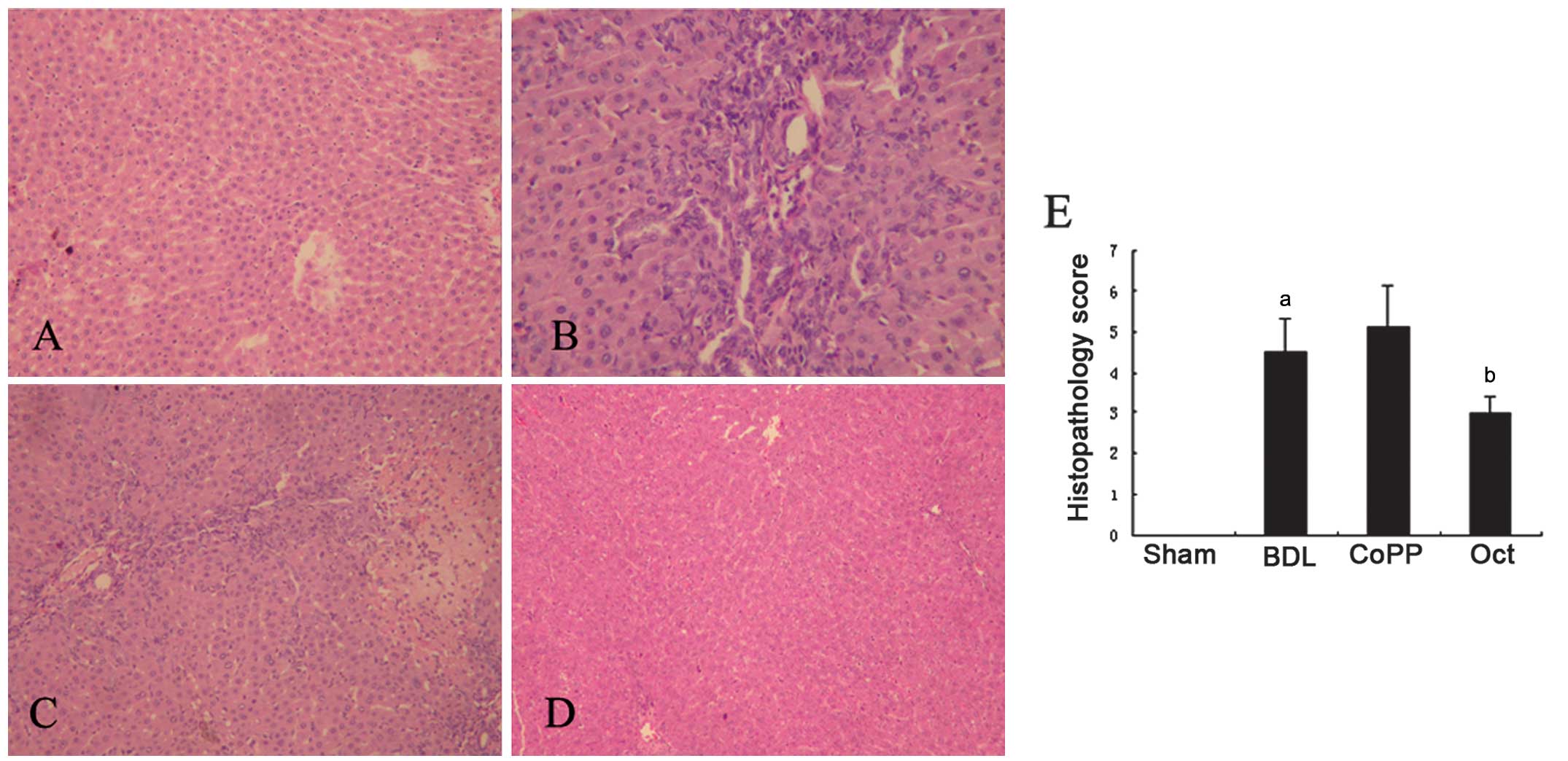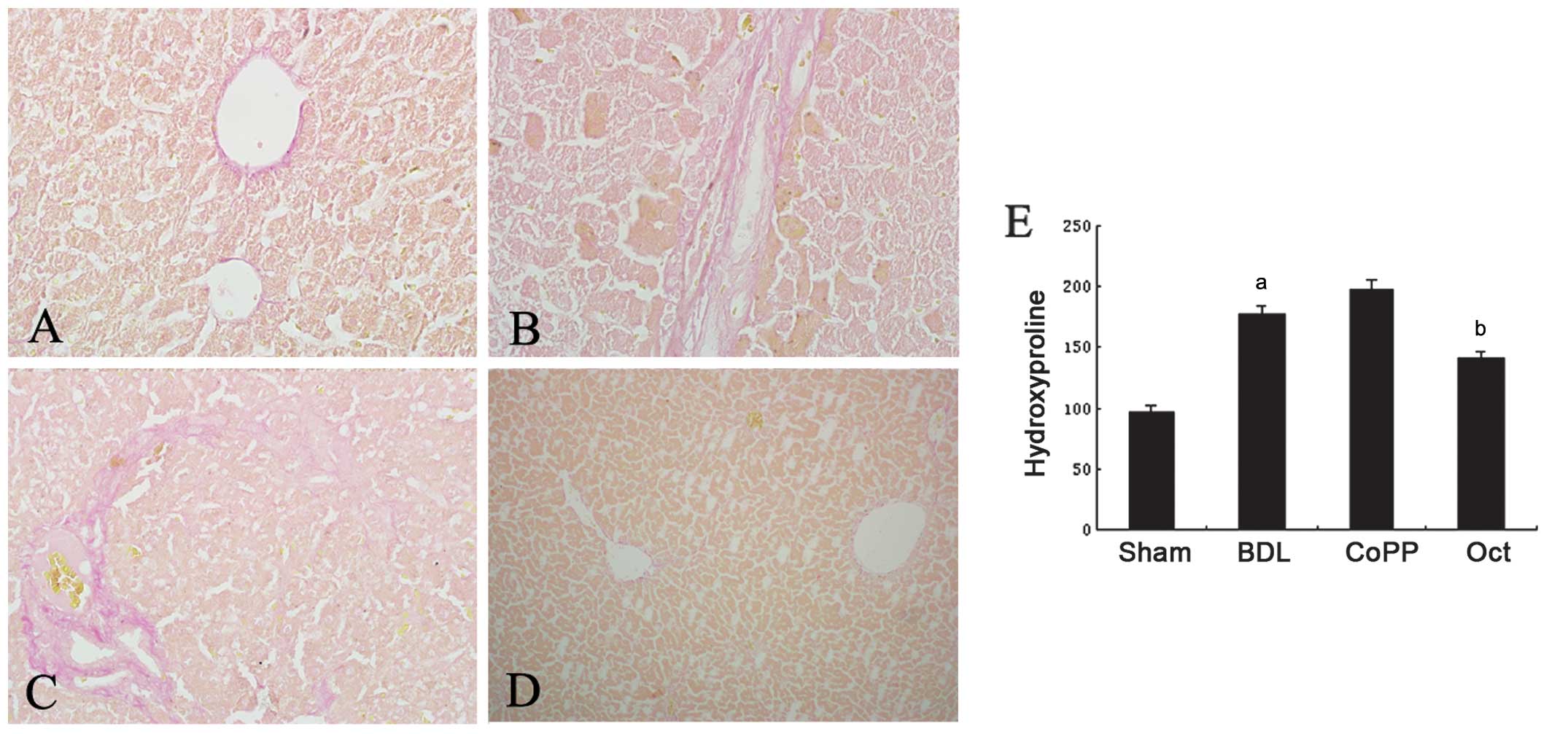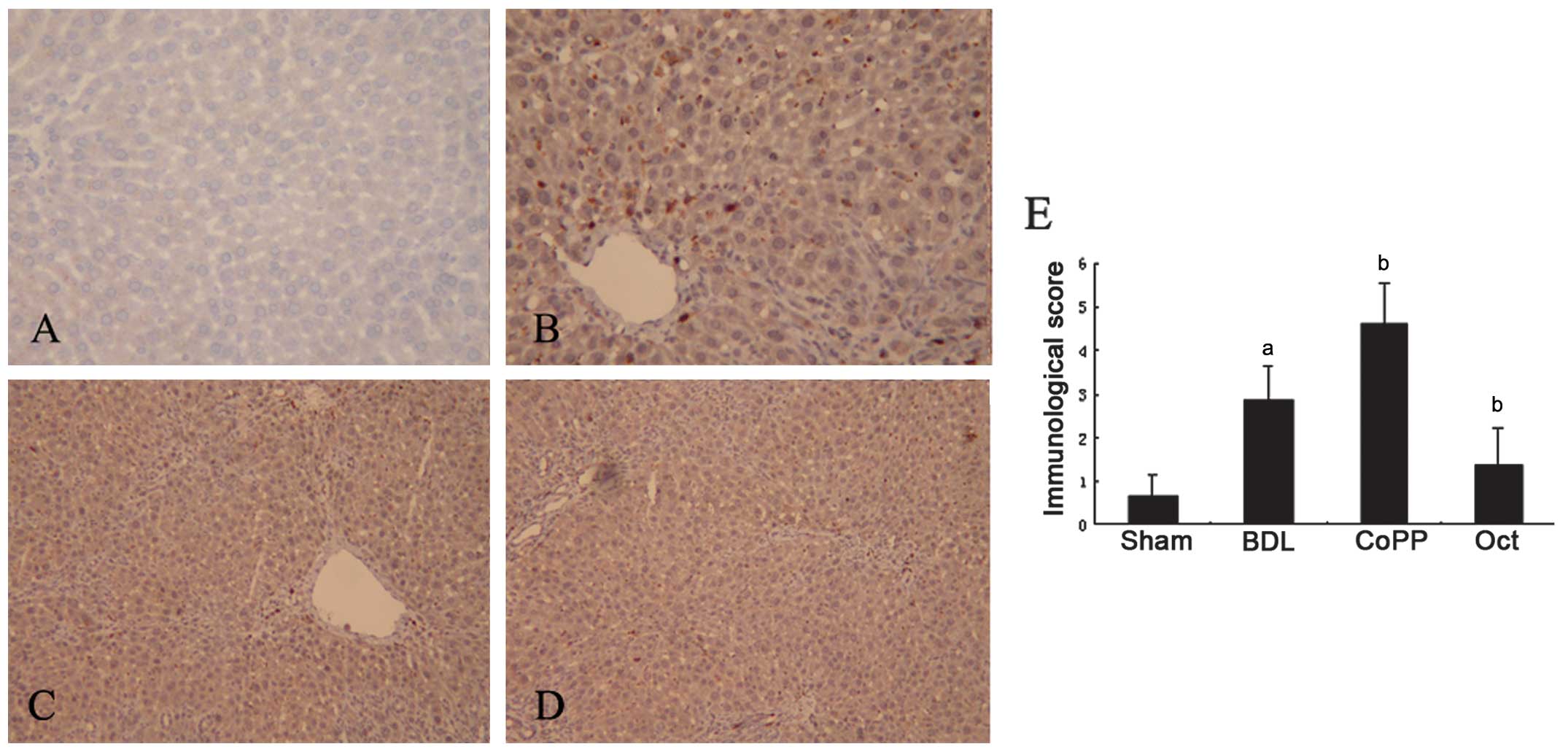|
1
|
Montaño-Loza A and Meza-Junco J:
Pathogenesis of portal hypertension. Rev Invest Clin. 57:596–607.
2005.(In Spanish).
|
|
2
|
Augustin S, González A and Genescà J:
Acute esophageal variceal bleeding: Current strategies and new
perspectives. World J Hepatol. 2:261–274. 2010. View Article : Google Scholar : PubMed/NCBI
|
|
3
|
Bosch J and Abraldes JG: Variceal
bleeding: pharmacological therapy. Dig Dis. 23:18–29. 2005.
View Article : Google Scholar : PubMed/NCBI
|
|
4
|
Reyes Dorantes AA: Endoscopic management
of variceal bleeding. Rev Gastroenterol Mex. 70:50–55. 2005.(In
Spanish).
|
|
5
|
Zhou DX, Zhou HB, Wang Q, et al: The
effectiveness of the treatment of octreotide on chylous ascites
after liver cirrhosis. Dig Dis Sci. 54:1783–1788. 2009. View Article : Google Scholar : PubMed/NCBI
|
|
6
|
Kim YM, Pae HO, Park JE, et al: Heme
oxygenase in the regulation of vascular biology: from molecular
mechanisms to therapeutic opportunities. Antioxid Redox Signal.
14:137–167. 2011. View Article : Google Scholar : PubMed/NCBI
|
|
7
|
Ryter SW and Choi AM: Heme
oxygenase-1/carbon monoxide: from metabolism to molecular therapy.
Am J Respir Cell Mol Biol. 41:251–260. 2009. View Article : Google Scholar : PubMed/NCBI
|
|
8
|
Kwok SC: Zinc Protoporphyrin Upregulates
Heme Oxygenase-1 in PC-3 Cells via the Stress Response Pathway. Int
J Cell Biol. 2013:1620942013.PubMed/NCBI
|
|
9
|
Leffler CW, Parfenova H, Jaggar JH and
Wang R: Carbon monoxide and hydrogen sulfide: gaseous messengers in
cerebrovascular circulation. J App Physiol. 100:1065–1076. 2006.
View Article : Google Scholar : PubMed/NCBI
|
|
10
|
Li Volti G, Sacerdoti D, Di Giacomo C, et
al: Natural heme oxygenase-1 inducers in hepatobiliary function.
World J Gastroenterol. 14:6122–6132. 2008.PubMed/NCBI
|
|
11
|
Tarquini R, Masini E, La Villa G, et al:
Increased plasma carbon monoxide in patients with viral cirrhosis
and hyperdynamic circulation. Am J Gastroenterol. 104:891–897.
2009. View Article : Google Scholar : PubMed/NCBI
|
|
12
|
Pereira RM, dos Santos RA, Oliveira EA, et
al: Development of hepatorenal syndrome in bile duct ligated rats.
World J Gastroenterology. 14:4505–4511. 2008. View Article : Google Scholar : PubMed/NCBI
|
|
13
|
Amersi F, Buelow R, Kato H, et al:
Upregulation of heme oxygenase-1 protects genetically fat Zucker
rat livers from ischemia/reperfusion injury. J Clin Invest.
104:1631–1639. 1999. View
Article : Google Scholar : PubMed/NCBI
|
|
14
|
Tilney HS, Lovegrove RE, Purkayastha S, et
al: Comparison of colonic stenting and open surgery for malignant
large bowel obstruction. Surg Endosc. 21:225–233. 2007. View Article : Google Scholar : PubMed/NCBI
|
|
15
|
Brown KE, Poulos JE, Li L, et al: Effect
of vitamin E supplementation on hepatic fibrogenesis in chronic
dietary iron overload. Am J Physiol. 272:G116–G123. 1997.PubMed/NCBI
|
|
16
|
Prentø P: Van Gieson’s picrofuchsin. The
staining mechanisms for collagen and cytoplasm, and an examination
of the dye diffusion rate model of differential staining.
Histochemistry. 99:163–174. 1993.
|
|
17
|
Kakinuma S1, Tanaka Y, Chinzei R, et al:
Human umbilical cord blood as a source of transplantable hepatic
progenitor cells. Stem Cells. 21:217–227. 2003.PubMed/NCBI
|
|
18
|
Makino N, Suematsu M, Sugiura Y, et al:
Altered expression of heme oxygenase-1 in the livers of patients
with portal hypertensive diseases. Hepatology. 33:32–42. 2001.
View Article : Google Scholar : PubMed/NCBI
|
|
19
|
Wei CL, Lee KH, Khoo HE and Hon WM:
Expression of haem oxygenase in cirrhotic rat liver. J Pathol.
199:324–334. 2003. View Article : Google Scholar : PubMed/NCBI
|
|
20
|
Thabut D and Bernard-Chabert B: Management
of acute bleeding from portal hypertension. Best Pract Res Clin
Gastroenterol. 21:19–29. 2007. View Article : Google Scholar : PubMed/NCBI
|
|
21
|
Dib N, Oberti F and Calès P: Current
management of the complications of portal hypertension: variceal
bleeding and ascites. CMAJ. 174:1433–1443. 2006. View Article : Google Scholar : PubMed/NCBI
|
|
22
|
Mileti E and Rosenthal P: Management of
portal hypertension in children. Curr Gastroenterol Rep. 13:10–16.
2011. View Article : Google Scholar : PubMed/NCBI
|
|
23
|
Reynaert H and Geerts A: Pharmacological
rationale for the use of somatostatin and analogues in portal
hypertension. Aliment Pharmacol Ther. 18:375–386. 2003. View Article : Google Scholar : PubMed/NCBI
|
|
24
|
Gøtzsche PC and Hróbjartsson A:
Somatostatin analogues for acute bleeding oesophageal varices.
Cochrane Database Syst Rev. 2008:CD0001932008.
|
|
25
|
Zhang HB, Wong BC, Zhou XM, et al: Effects
of somatostatin, octreotide and pitressin plus nitroglycerine on
systemic and portal haemodynamics in the control of acute variceal
bleeding. Int J Clin Pract. 56:447–451. 2002.PubMed/NCBI
|
|
26
|
Rodriguez F, Kemp R, Balazy M and
Nasjletti A: Effects of exogenous heme on renal function: role of
heme oxygenase and cyclooxygenase. Hypertension. 42:680–684. 2003.
View Article : Google Scholar : PubMed/NCBI
|
|
27
|
Naik JS, O’Donaughy TL and Walker BR:
Endogenous carbon monoxide is an endothelial-derived vasodilator
factor in the mesenteric circulation. Am J Physiol Heart Circ
Physiol. 284:H838–H845. 2003.PubMed/NCBI
|
|
28
|
Carter EP, Hartsfield CL, Miyazono M, et
al: Regulation of heme oxygenase-1 by nitric oxide during
hepatopulmonary syndrome. Am J Physiol Lung Cell Mol Physiol.
283:L346–L353. 2002.PubMed/NCBI
|
|
29
|
Pae HO, Lee YC and Chung HT: Heme
oxygenase-1 and carbon monoxide: emerging therapeutic targets in
inflammation and allergy. Recent Pat Inflamm Allergy Drug Discov.
2:159–165. 2008. View Article : Google Scholar : PubMed/NCBI
|
|
30
|
Ashino T, Yamanaka R, Yamamoto M, et al:
Negative feedback regulation of lipopolysaccharide-induced
inducible nitric oxide synthase gene expression by heme oxygenase-1
induction in macrophages. Mol Immunol. 45:2106–2115. 2008.
View Article : Google Scholar : PubMed/NCBI
|
|
31
|
Naik JS and Walker BR: Heme
oxygenase-mediated vasodilation involves vascular smooth muscle
cell hyperpolarization. Am J Physiol Heart Circ Physiol.
285:H220–H228. 2003.PubMed/NCBI
|
|
32
|
Xi Q, Tcheranova D, Parfenova H, et al:
Carbon monoxide activates KCa channels in newborn arteriole smooth
muscle cells by increasing apparent Ca2+ sensitivity of
alpha-subunits. Am J Physiol Heart Circ Physiol. 286:H610–H618.
2004. View Article : Google Scholar : PubMed/NCBI
|
|
33
|
Blendis L and Wong F: The hyperdynamic
circulation in cirrhosis: an overview. Pharmacol Ther. 89:221–231.
2001. View Article : Google Scholar : PubMed/NCBI
|
|
34
|
Kim MY and Baik SK: Hyperdynamic
circulation in patients with liver cirrhosis and portal
hypertension. Korean J Gastroenterol. 54:143–148. 2009. View Article : Google Scholar : PubMed/NCBI
|
|
35
|
Froh M, Conzelmann L, Walbrun P, et al:
Heme oxygenase-1 overexpression increases liver injury after bile
duct ligation in rats. World J Gastroenterol. 13:3478–3486. 2007.
View Article : Google Scholar : PubMed/NCBI
|
|
36
|
Guo SB, Duan ZJ, Li Q and Sun XY: Effects
of heme oxygenase-1 on pulmonary function and structure in rats
with liver cirrhosis. Chin Med J (Engl). 124:918–922.
2011.PubMed/NCBI
|
|
37
|
Guo SB, Duan ZJ, Li Q and Sun XY: Effect
of heme oxygenase-1 on renal function in rats with liver cirrhosis.
World J Gastroenterol. 17:322–328. 2011. View Article : Google Scholar : PubMed/NCBI
|
|
38
|
Yang H, Zhao LF, Zhao ZF, et al: Heme
oxygenase-1 prevents liver fibrosis in rats by regulating the
expression of PPARgamma and NF-kappaB. World J Gastroenterol.
18:1680–1688. 2012. View Article : Google Scholar : PubMed/NCBI
|
|
39
|
Malaguarnera L, Madeddu R, Palio E, Arena
N and Malaguarnera M: Heme oxygenase-1 levels and oxidative
stress-related parameters in non-alcoholic fatty liver disease
patients. J Hepatol. 42:585–591. 2005. View Article : Google Scholar : PubMed/NCBI
|
|
40
|
Wen T, Guan L, Zhang YL and Zhao JY:
Dynamic changes of heme oxygenase-1 and carbon monoxide production
in acute liver injury induced by carbon tetrachloride in rats.
Toxicology. 228:51–57. 2006. View Article : Google Scholar : PubMed/NCBI
|
|
41
|
Zeng Z, Huang HF, Chen MQ, Song F and
Zhang YJ: Heme oxygenase-1 protects donor livers from
ischemia/reperfusion injury: the role of Kupffer cells. World J
Gastroenterol. 16:1285–1292. 2010. View Article : Google Scholar : PubMed/NCBI
|
|
42
|
Barikbin R, Neureiter D, Wirth J, et al:
Induction of heme oxygenase 1 prevents progression of liver
fibrosis in Mdr2 knockout mice. Hepatology. 55:553–562. 2012.
View Article : Google Scholar : PubMed/NCBI
|
|
43
|
Wang QM, Duan ZJ, Du JL, et al: Heme
oxygenase/carbon monoxide pathway inhibition plays a role in
ameliorating fibrosis following splenectomy. Int J Mol Med.
31:1186–1194. 2013.PubMed/NCBI
|
|
44
|
Geuken E, Buis CI, Visser DS, et al:
Expression of heme oxygenase-1 in human livers before
transplantation correlates with graft injury and function after
transplantation. Am J Transplant. 5:1875–1885. 2005. View Article : Google Scholar : PubMed/NCBI
|
|
45
|
Duan ZJ, Yang D, Wang F, et al: Heme
oxygenase-1 regulates the major route involved in formation of
immune hepatic fibrosis in rats. Chinese Med J (Engl).
123:3304–3308. 2010.PubMed/NCBI
|
|
46
|
Wang QM, Du JL, Duan ZJ, et al: Inhibiting
heme oxygenase-1 attenuates rat liver fibrosis by removing iron
accumulation. World J Gastroenterol. 19:2921–2934. 2013.PubMed/NCBI
|
|
47
|
Wang QM, Yin XY, Duan ZJ, Guo SB and Sun
XY: Role of the heme oxygenase/carbon monoxide pathway in the
pathogenesis and prevention of hepatic encephalopathy. Mol Med Rep.
8:67–74. 2013.PubMed/NCBI
|














